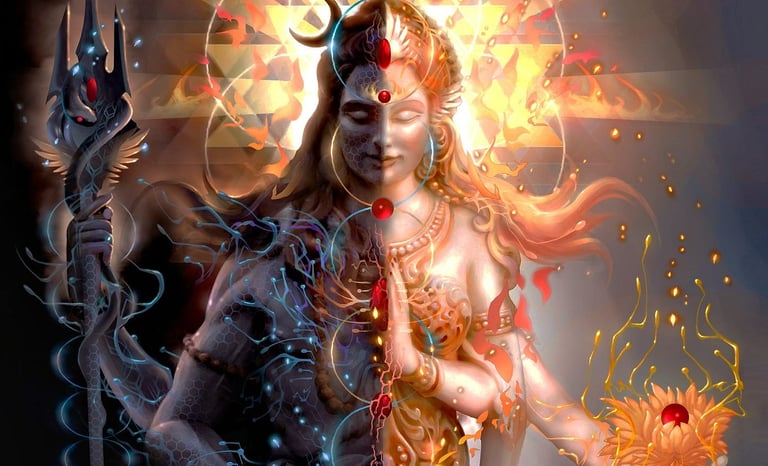Vigyan Bhairav Tantra: The most practical guide to enlightenment
SPIRITUALITY
Sahil Sharma
10/28/20233 min read


Vigyan Bhairav Tantra, a sacred and profound text from the world of Tantra, offers a window into the mystical traditions of ancient India. This spiritual classic, also known as the "Science of Self-Realization," is a guide to self-discovery, meditation, and a deeper understanding of the universe. In this article, we will explore the origins, teachings, and significance of the Vigyan Bhairav Tantra, including the 112 paths to enlightenment and the unique 113th path of pure devotion.
The Historical Context
The Vigyan Bhairav Tantra is part of a broader group of texts known as the "Tantras." These texts are associated with various aspects of Hinduism, Buddhism, and Jainism and explore the esoteric aspects of these religions. The Tantra tradition has a long and complex history, influenced by a wide range of spiritual, philosophical, and cultural influences over the centuries.
Origins and Authorship
The Vigyan Bhairav Tantra is attributed to Lord Shiva, one of the principal deities in Hinduism. According to legend, it is a conversation between Lord Shiva and the Goddess Parvati. Shiva imparts his profound wisdom to Parvati in 112 sutras or verses, each of which is a meditation technique or a contemplative practice. These sutras are collectively known as "Dharanas."
Key Teachings
Consciousness and the Universe: The Vigyan Bhairav Tantra delves into the nature of consciousness and the interconnectedness of the individual soul (Atman) with the universal consciousness (Brahman). It teaches that every individual has the potential to realize their divine nature through meditation and self-awareness.
Meditation Techniques: The text offers a wide array of meditation techniques, each designed to help practitioners explore their inner selves and achieve a state of higher consciousness. These techniques range from breath awareness and visualization to concentration on various aspects of the body, mind, and senses.
Non-Duality: One of the core teachings of the Vigyan Bhairav Tantra is the concept of non-duality (Advaita). It emphasizes that the ultimate reality is one, and that the apparent duality of the world is an illusion. By meditating on this oneness, individuals can transcend the limitations of the ego and realize their true nature.
Spontaneous Awareness: The text encourages the practitioner to develop spontaneous awareness and a meditative state that transcends conscious effort. It suggests that meditation can be effortless, leading to a natural state of pure consciousness.
Expansion of Awareness: The Tantra also explores the expansion of consciousness by contemplating various experiences, emotions, and sensory perceptions. This expansion of awareness allows practitioners to go beyond the limitations of the mind and body.
The 113th Path: Pure Devotion
A remarkable aspect of the Vigyan Bhairav Tantra is the existence of the 113th path, which embodies the power of pure devotion. While the text primarily focuses on meditation and self-realization through various techniques, it also acknowledges the profound path of devotion that transcends all other practices.
In this path of pure devotion, Parvati herself, the seeker, turned to Shiva with unwavering faith and love. Her devotion was so pure and profound that it captured Shiva's heart. Shiva, the embodiment of the ultimate reality, was moved by Parvati's sincerity and granted her the highest spiritual knowledge and blessings. This exemplifies the idea that devotion and surrender to the divine can be a direct and powerful path to self-realization.
Significance and Impact
The Vigyan Bhairav Tantra is considered a spiritual treasure by those who seek self-realization and inner transformation. It has been embraced by various spiritual traditions, including Hinduism, Buddhism, and New Age spirituality. Its teachings are universal and can be applied by people of different backgrounds and beliefs.
The text has also inspired numerous scholars, yogis, and spiritual teachers throughout history, including Osho (Rajneesh), who dedicated extensive commentaries to the Vigyan Bhairav Tantra, introducing it to a global audience.
In contemporary society, where stress, anxiety, and the search for inner peace are prevalent, the practices outlined in the Vigyan Bhairav Tantra can provide valuable tools for individuals seeking spiritual growth, mindfulness, and a deeper understanding of themselves and the universe.
Conclusion
The Vigyan Bhairav Tantra, a timeless text believed to be revealed by Lord Shiva himself, offers profound insights into the nature of consciousness, meditation, and self-realization. Its teachings have resonated with spiritual seekers for centuries, and they continue to inspire and guide individuals on their quest for inner transformation and understanding. Whether you are a seasoned meditator or someone looking to begin a spiritual journey, the wisdom of the Vigyan Bhairav Tantra, including the 112 paths to enlightenment and the path of pure devotion, has the potential to illuminate your path to self-discovery and higher consciousness.
